History
North and South Charford are usually identified with the "Cerdic's ford" which appears twice in the Anglo-Saxon Chronicle . It first is mentioned under the entry for the year 508 when we are told that following a battle to the east "the land as far as Cerdic's ford was named Natanleaga [1] " For the year 519 we are told that "Cerdic and Cynric succeeded to the kingdom [of the West Saxons]; and in the same year they fought against the Britons at a place called Cerdic's ford". If a battle really did take place here then it is possible that the boundary of Hampshire was first established here. [2]
In the time of the Domesday Book of 1086, North Charford (Cerdeford) was a fairly large settlement of 29 households. [3] The lands were split between the Earl of Salisbury and "Alwy son of Turber". [3] That which Alwy owned may subsequently have become the manor of Hale. [4] Richard II was overlord of North Charford in 1397, but subsequently the Bulkeleys claimed the overlordship, asserting that the manor was held of them as of their manor of Nether Burgate and their hundred of Fordingbridge. [5] This was denied by Edward Abarowe, lord of North Charford in 1563, but seventy years later Sir William Bulkeley was stated to be the overlord. [5]
In the beginning of the 13th century Hamo de Bachamton and Geoffrey son of John held the manor conjointly. [5] Around 1280 William Gerberd held the manor, which passed to his heir John Gerberd. [5] Alice was holding it in 1316. Her son William Gerberd sold the manor before 1353 to Walter Abarowe, on whose death it passed to his widow Isabel. [5] She subsequently married Hugh Tyrell, and died in 1370, leaving a son and heir John Abarowe. [5] The manor remained in the Abarowe family down to the 17th century. [5] It was purchased in the 18th century by Thomas Archer, or his nephew Henry Archer, who was holding it at the time of his death in 1768. [5] It then followed the same descent as Hale until the 19th century, when it was sold to John Coventry of Burgate manor. [5]
A chapel was built by the beginning of the 14th century. It is said to have been founded for one priest "to sing in the same chapel for the ease of the inhabitants of the manor of North Chartforde." [5] The chapel with its tithes is mentioned in 1628, but before 1727 it was in ruins, and there is no trace of it at the present day. [5]
North Charford was an ancient parish, usually considered separate from that of South Charford. [5] The population of North Charford in 1870 was just 70 people living in 15 houses. [6] By the beginning of the 20th century North Charford consisted of only a few scattered houses and the old manor-house, converted in 1880 by Professor Wrightson into an agricultural college. [5] In 1931 the parish had a population of 198. [7] On 1 April 1932 the parish was abolished and merged with Breamore and Hale. [8]
Today, the old manor of North Charford is located in the civil parish of Breamore, on the west bank of the River Avon. The Ordnance Survey though, also marks North Charford about one mile to the east in the village of Hale. The ancient parish having comprised land on both the west and east sides of the River Avon.

Cerdic is described in the Anglo-Saxon Chronicle as a leader of the Anglo-Saxon settlement of Britain, being the founder and first king of Wessex, reigning from around 519 to 534 AD. Subsequent kings of Wessex were each claimed by the Chronicle to descend in some manner from Cerdic. His origin, ethnicity, and even his very existence have been extensively disputed. However, though claimed as the founder of Wessex by later West Saxon kings, he would have been known to contemporaries as king of the Gewissae, a folk or tribal group. The first king of the Gewissae to call himself 'King of the West Saxons', was Cædwalla, in a charter of 686.

The River Avon is in the south of England, rising in Wiltshire, flowing through that county's city of Salisbury and then west Hampshire, before reaching the English Channel through Christchurch Harbour in the Bournemouth, Christchurch and Poole conurbation of Dorset.

Fordingbridge is a town and broader civil parish with a population of 6,000 on the River Avon in the New Forest District of Hampshire, England, near the Dorset and Wiltshire borders and on the edge of the New Forest, famed for its late medieval seven-arch bridge.
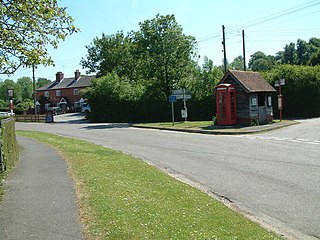
Woodgreen is a village and civil parish within the New Forest district of Hampshire in England.

Rockbourne is a village and civil parish in the English county of Hampshire, close to Fordingbridge.

Breamore is a village and civil parish near Fordingbridge in Hampshire, England. The parish includes a notable Elizabethan country house, Breamore House, built with an E-shaped ground plan. The Church of England parish church of Saint Mary has an Anglo-Saxon rood.

Godshill is a village and civil parish and in New Forest National Park in Hampshire, England. It is about 1+1⁄2 miles (2.4 km) east of the town of Fordingbridge and 10 miles (16 km) south of the city of Salisbury.

Hale is a small village and civil parish in Hampshire, England. It lies on the border of the New Forest, overlooking the valley of the River Avon. The village is about 3.5 miles (5.6 km) north-east of the town of Fordingbridge, and about 8 miles (13 km) south of the city of Salisbury. Within the parish stands Hale House, a large 18th-century mansion which was the country house of architect Thomas Archer, who also rebuilt Hale church in 1717.

Cogges is an area beside the River Windrush in Witney, in the West Oxfordshire district, in Oxfordshire, England, 0.5 miles (800 m) east of the town centre. It had been a separate village and until 1932 it was a separate civil parish.

South Charford is a hamlet in the New Forest district, in Hampshire, England. It is in the civil parish of Breamore on the west bank of the River Avon.

Bickton is a hamlet in the New Forest District of Hampshire, England. It is within the civil parish of Fordingbridge and is situated by the River Avon.

Ibsley is a village and former civil parish, now in the parish of Ellingham, Harbridge and Ibsley, in the New Forest district, in Hampshire, England. It is about 2.5 miles (4 km) north of the town of Ringwood. In 1931 the parish had a population of 228.

Harbridge is a small village and former civil parish, now in the parish of Ellingham, Harbridge and Ibsley, in the New Forest district, in the county of Hampshire, England. It is located some four kilometres north of Ringwood and a similar distance south of Fordingbridge, in southwest Hampshire. In 1931 the parish had a population of 276.

Netley Marsh is a village and civil parish in Hampshire, close to the town of Totton. It lies within the New Forest District, and the New Forest National Park. It is the supposed site of the battle between an invading Anglo Saxon army, under Cerdic and a British army under the probably fictitious king Natanleod in the year 508.

Sopley is a village and civil parish situated in the New Forest National Park of Hampshire, England. It lies on the old main road from Christchurch to Ringwood, on the east bank of the River Avon. The parish extends east as far as Thorny Hill and borders the parishes of Bransgore and Burton to the south and west respectively. It lies down the road from a small hamlet called Ripley. It includes the hamlets of Shirley, Avon and Ripley. The area is mainly rural with less than 300 dwellings.
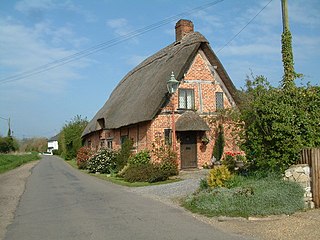
Burgate is a hamlet situated on the western edge of the New Forest National Park in Hampshire, England. The hamlet is situated on the A338 road. The nearest town is Fordingbridge, which lies approximately 0.5 miles (1 km) to the southwest.
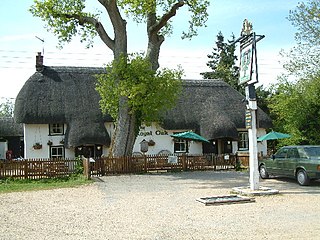
North Gorley is a hamlet in the New Forest National Park of Hampshire, England. Its nearest town is Fordingbridge, which lies approximately 2 miles (3.2 km) north of the hamlet.
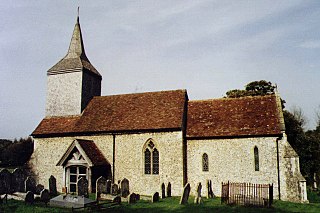
Stoke Charity is a small village and former civil parish, now in the parish of Wonston, in the City of Winchester district of Hampshire, England. It is on the River Dever, its nearest town is Winchester, which lies approximately 6.1 miles (9.9 km) south-west from the village. In 1931 the parish had a population of 111.
John Doddington was an English landowner and politician who sat in the House of Commons in 1640.
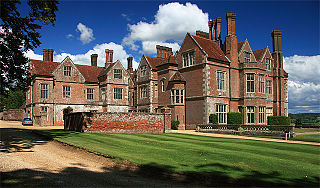
Sir William Doddington (1572–1638) was an English landowner and politician who sat in the House of Commons from 1621 to 1622.





















